“We didn’t know we’d be forming a chapter of ACT UP when a small group of us began meeting in Dublin last summer,” says Andrew Leavitt, as a new wave of HIV activism in Ireland is taking its inspiration from the erce examples set 30 years ago.
Born during the darkest and most hopeless days of the AIDS epidemic in the US, ACT UP – the AIDS Coalition To Unleash Power – showed that a relatively small group of determined activists could change the course of an epidemic. Today, amidst record numbers of new HIV diagnoses here in Ireland, a new wave of HIV activism takes inspiration from the fierce example set 30 years ago.
Before ACT UP, the LGBT community’s response to the AIDS crisis in the US largely centred on providing desperately needed care and support. In March 1987, in a fiery speech at New York City’s Lesbian and Gay Community Services Center, playwright Larry Kramer described a litany of government failures that were exacerbating the epidemic and its devastation, and he castigated the politically powerless AIDS service organisations.
After six years of rising deaths, government inaction, public hostility; six years of deepening anger and frustration, Kramer’s call for “a new organisation devoted to political action” found a community ready to act.
Days later, over 300 people returned to the community centre to create the first ACT UP – “a diverse, non-partisan group of individuals united in anger and committed to direct action to end the AIDS crisis.” Within weeks they held their first demonstration: a ‘die-in’ on Wall Street protesting pharmaceutical companies’ greed and government inaction. 17 people were arrested after blocking traffic for several hours. From despair and darkness, ACT UP exploded into the world full of anger and defiance.
With the rallying cry “Silence = Death,” ACT UP offered action and empowerment instead of helplessness. Eschewing hospital gowns for combat boots and leather jackets, they transformed what it meant to live with HIV, and made activism sexy, even fashionable.
ACT UP quickly spread nationwide with independent chapters forming in dozens of cities. As numbers grew, the actions grew larger and more daring. Blocking traffic, shutting down the Federal Drug Administration, and even shutting down the New York Stock Exchange by dumping thousands of fake dollar bills onto the trading floor, activists forced AIDS onto the national agenda.
Some results came quickly. In just a few years ACT UP helped accelerate the process for drug development and approval, transformed the way research is conducted, forced drug companies to lower prices for treatments, and changed policy from national to the local level.
In an era when even doctors struggled to keep abreast of scientific and medical developments, activists were often better informed than the officials whose policies they challenged. Some quickly recognised the value of the activists’ knowledge, as when Tony Fauci, a prominent AIDS researcher, famously interrupted the arrest of protesters to invite them into a meeting.
The headline-grabbing tactics, and ever-growing list of achievements inspired activists across the globe who formed international chapters – including an earlier incarnation in Dublin in the early 1990s – a number of whom, like ACT UP Paris, are still active today. Assertive, radically democratic, and committed to keeping people with HIV at the centre of the response, ACT UP provided a powerful example of what HIV activism could accomplish.
Today, we are in a very different place than 30 years ago. Thanks in no small part to the work of early activists, we have a wide range of powerful and effective treatments for HIV. Instead of hospital wards filled with the sick and dying, HIV care is delivered in outpatient clinics. Responsibility for education and prevention has largely been taken on by state agencies and NGOs.
But while we’ve made enormous medical advances, progress on other fronts has lagged behind. Ignorance and fear around HIV remains high. People living with HIV continue to experience discrimination, have little in the way of social support, and few feel comfortable being open about their status. Underfunded sexual health services struggle to meet the community’s needs. And new HIV diagnoses among gay and bisexual men in Ireland have been steadily rising for the last decade, with new diagnoses overall at the highest levels ever recorded.
We didn’t know we’d be forming a chapter of ACT UP when a small group of us began meeting in Dublin last summer. Agreeing that we are in the midst of a new HIV crisis, that the response from the Government, the State, and from our own community was falling short, we wanted to figure out what we could do, how we could change things.
It was serendipity, then, that a member of ACT UP London visited Dublin for a screening of the documentary United In Anger: A History of ACT UP. Comprised of original footage of meetings and actions, with interviews with former members of ACT UP New York, the film introduced the group’s in-yourface style of direct action to many who’d never heard of it. We soon decided that what was missing in Ireland was a clear, outspoken political voice on HIV, and that ACT UP’s spirit of fearless, insistent action was exactly what was needed.
The HIV crisis of today is very different than 30 years ago, the situation less desperate, and our tactics reflect that changed reality. But ACT UP was never about applying a one-size-fits-all model; it was about identifying problems and taking action to solve them.
With the tools available today – effective treatment, PEP, PrEP, undetectable status, rapid testing – we should be making huge strides towards ending the epidemic. But for that to happen requires political will. HIV needs to become a priority again for this community, and we need to let politicians and decision makers know that they must do more.
Find out more at
actupdublin.com
The HIV & AIDS Time-line
The emerging epidemic 1981-84
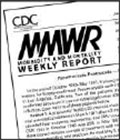
First reports of AIDS in US

Larry Kramer, GMHC & ACT UP
5th June 1981: The US Centers for Disease Control (CDC) reports five cases of Pneumocystis Pneumonia in previously healthy gay men.
Jan 1982: Gay Men's Health Crisis, the first community-based AIDS Service Organisation in the US is founded in New York.
1984: The retrovirus that causes Acquired Immune Deficiency Syndrome (AIDS) is identified.
Social and political response 1985-86

Rock Hudson dies aged 52
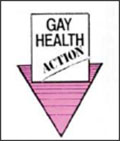
GHA formed in Ireland
Oct 1985: Actor, Rock Hudson died from AIDS -related illness – the first high-profile death.
1985: Irish activists form Gay Health Action (GHA) in response to impact of AIDS among gay and bi men in Ireland. Gay sex is still illegal in Ireland.
Feb 1986: US President Reagan mentions AIDS for the first time in a message to Congress.
Activists fight back 1987-88
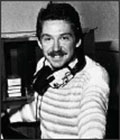
Vincent Hanely dies aged 33
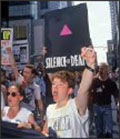
ACT UP is formed in New York
Jan 1987: The British Government launches a public information campaign called, "AIDS: Don't Die of Ignorance".
March 1987: In New York, AIDS Coalition To Unleash Power (ACT UP) is founded.
April 1987: DJ and TV presenter, Vincent Hanley is the first Irish celebrity to die from an AIDS-related illness.
Economic and social cost 1989-94
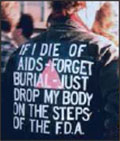
ACT UP protest drug prices

Freddie Murcury dies at 45
Sept 1989: ACT UP protest against the high price of AIDS drug, AZT at the New York Stock Exchange. Drug company lowers price.
Nov 1991:
Queen frontman, Freddie Mercury dies of AIDS-related pneumonia.
Nov 1994: Performer, Thom McGinty AKA The Diceman speaks about living with HIV on Irish TV, four months before his AIDS-related death.
Medical breakthroughs 1996-98

AIDS-related deaths peak
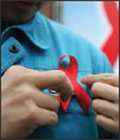
AIDS-related deaths decline
1996: Combination antiretroviral treatment is shown to be highly effective against HIV.
1997: Worldwide deaths from AIDS are estimated at 6.4 million with 22 million people living with HIV in 85 countries.
1998: AIDS-related deaths began to decline in developed countries where combination antiretroviral treatment is available.
Turning the tide on HIV 2012-15
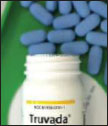
Truvada appoved as PrEP
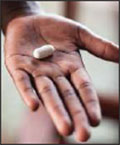
ART distrubution expands
2012: Truvada approved for use as PrEP (Pre-Exposure Prophylaxis) in the US.
2014: PARTNER study finds no sexual transmission of HIV when a person's viral load is undetectable.
2015: Half the people living with HIV worldwide have access to antiretroviral treatment.